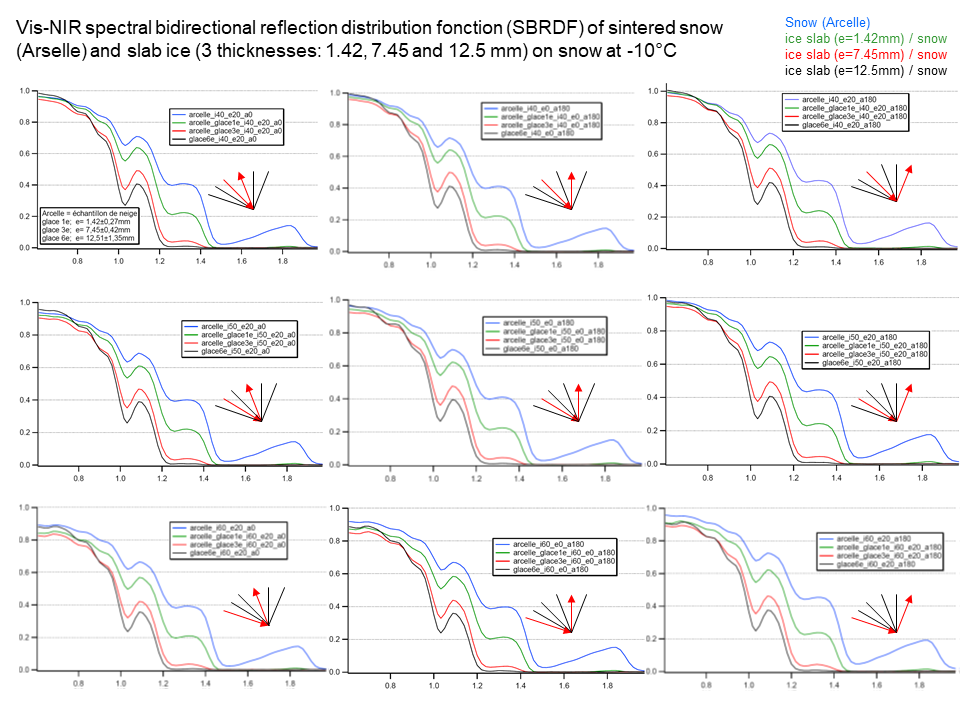- Title
- Vis-NIR spectral bidirectional reflection distribution fonction (SBRDF) of sintered snow (Arselle) and slab ice (3 thicknesses: 1.42, 7.45 and 12.5 mm) on snow at -10°C
- DOI
- 10.26302/SSHADE/EXPERIMENT_BS_20160831_000
- Data reference
- Brissaud, Olivier; Schmitt, Bernard; Douté, Sylvain (2009): Vis-NIR spectral bidirectional reflection distribution fonction (SBRDF) of sintered snow (Arselle) and slab ice (3 thicknesses: 1.42, 7.45 and 12.5 mm) on snow at -10°C. SSHADE/GhoSST (OSUG Data Center). Dataset/Spectral Data. https://doi.org/10.26302/SSHADE/EXPERIMENT_BS_20160831_000
- Publications
- Database(s)
- Experimentalists
- Type(s)
- laboratory measurement
- Description
- Vis-NIR BRDF spectra of sintered snow (from Arselle) [i=0, 20, 30, 40, 50, 60, 65°; e=0, 20, 40, 50, 65°; az=0, 45, 90, 140, 160, 180°], of snow with a thin top slab of ice (3 thicknesses: 1.42, 7.45, 12.5mm) [i=40, 50, 60, 70°; e=0, 10, 20°; az=0, 45, 90, 140, 160, 180°], and of the specular peak of the 12.5mm slab [i=50, e=50°5°; i=65°, e=65°5°; az=170-180°] - T = -10°C
- Number of spectra
- 19
- Comments
- The sample was put into rotation in the spectro-radiogoniometer for the measurements. The sample completes a full rotation (10 s) during the measurement of the reflectance at one wavelength and one geometry. Each spectrum was thus integrated over 10 different positions of the sample
- Variable type(s)
-
- sample texture
- sample thickness
- incidence angle
- Comments
- series of combinations of illumination, observation and azimut geometries
- Instrument
- SHINE Spectro-Gonio bidirectional reflection Vis-NIR
- Sample holder
- stainless-steel cylinder in cold chamber
- Standard medium
- vacuum
- Observation mode
- spectrum
- Spectral range type(s)
- Vis, NIR
- Valid spectral range(s)
-
Min - Max () Sampling () Resolution () Position accuracy () Absorption edge #1 0.6 - 0.66 0.02 0.0047 0.001 #2 0.68 - 1.38 0.02 0.0095 0.002 #3 1.4 - 1.98 0.02 0.019 0.004
Definition: incidence and emergence angles are positive with origin at nadir, and vary in same direction. Azimuth origin (increasing clockwise) is for i = e (opposition geometry).
- Observation geometry
- bidirectional
- Observation mode
- tri-angular function
- Resolution illumination
- 0.1°
- Resolution observation
- 4.1°
Illumination
Observation
- Comments
- partial polarization variable with wavelength (from gratings)
- Observation mode
- single spot
- Spatial resolution
- 20.0 0.1
- Comments
- spatial resolution over x vary as 1/cos(obs angle)
- Date begin - end
- 2009-01-14 - 2009-03-12
Versions
- Release date
- 2020-03-17 11:55:30+0000 UTC
- Version (Date)
- #1 (2020-03-17 11:55:30+0000 UTC, Updated: 2020-03-18 14:21:56+0000 UTC)
- Sponsors
-
- Programme National de Planétologie - INSU/CNRS (PNP)
- Centre National d'Etudes Spatiales (CNES) (OMEGA/Mars Express)
